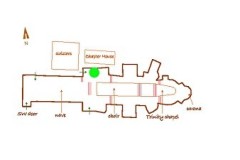Basics
Geology: Crinoidal Limestone
Age: Upper Devonian – Carboniferous
Provenance: Belgium
Where to see examples
memorial stones on Martyrdom floor (images below)
Archbishop Meopham tomb near Anselm chapel
Description
The terms “marble” and “limestone” are often, and confusingly, used as synonyms in the stone trade. There does, however, tend to be a distinction by some that stones containing plentiful fossils are described as limestones and those without as marbles. That distinction shall be used here.
The Belgian Black Limestone is a Carboniferous blue-grey limestone when freshly quarried, giving rise to the local name Pierre Bleue. Once polished the stone darkens. The stone consists mostly of microcrystalline calcite and a high proportion of fossils, mainly crinoids, but also containing brachiopods and occasional corals. There is also a small proportion of organic carbon giving the stone its dark colour.
The limestone was formed in a shallow-marine environment, in a warm tropical sea, inhabited by many invertebrate sea creatures. Those limestones with small white crinoidal fragments are usually referred to as Petit Granit, a name used since the early nineteenth century.
The limestone has been quarried since the Middle Ages from numerous quarries in southern Belgium, notably near Soignies in the Hainaut province. Petit Granit has an Appellation d’Origine Locale (Local Appellation of Origin); an indication used to specify inherent qualities that are essentially due to the locality where the stone is quarried. It is still quarried mainly from the Hainaut province and is used for decorative and artistic purposes, but mostly for use as a dimension stone for building exterior.



